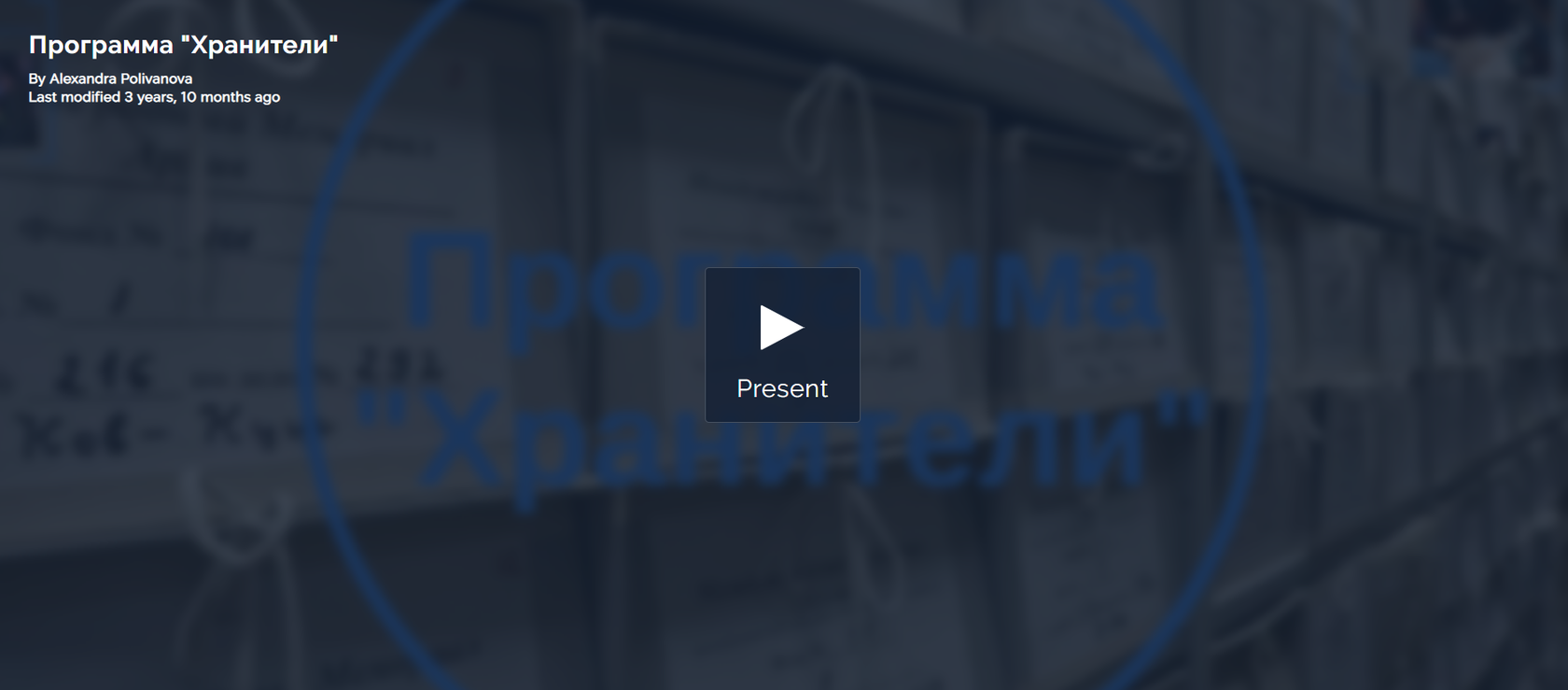Viewers' involvement
in interpretation and assessment of particular exhibits with the help of personal associations, stories inspired by certain items, voting
In this section we shift the accent in our interpretation scheme from relevant ideas, contexts and frames to museum resources and collections. And here we speak about their meanings not their objective descriptions, i.e. we approach the goal of heritage actualization and interpretation from a different perspective.
We conducted a series of experiments in this direction:
Number 1.
Students -participants of the first stage of the project — chose one item for a group and thought about what it meant today and what story associated with this object would be interesting. Eventually the group made an exhibit presentation with stories and offered possible forms of its interactive learning. The presentation was based on historical information and included remakes of the stories if needed.
On the whole, the experiment was quite productive. First of all, the task interested the participants. Second, the participants managed to create vivid enticing stories that widened their demonstration and perception diapason.
The opportunity to hold an authentic museum object, to feel the "breath" of the past played its role. One of the participants put it this way:
"It is amazing how many thoughts can be generated thanks to absolutely alien, at first glance, item and how dear it becomes when some story is tied up with it. Humor of different ages, how opium should be kept and even how granny smells are the things the stories imagined ed by acquisitive students mind" (Alina Arsitova, URFU student, a journalist at our June brainstorming sessions).
Among these exhibits there were:
Kid gloves and …
… a theme of a traveler’s snobbism. The object helps extend on attention to trifles, pricey quality travel accessories…
… the idea of long-lasting, thorough preparations …
… travel hygiene … in times without wet nap wipes
We conducted a series of experiments in this direction:
Number 1.
Students -participants of the first stage of the project — chose one item for a group and thought about what it meant today and what story associated with this object would be interesting. Eventually the group made an exhibit presentation with stories and offered possible forms of its interactive learning. The presentation was based on historical information and included remakes of the stories if needed.
On the whole, the experiment was quite productive. First of all, the task interested the participants. Second, the participants managed to create vivid enticing stories that widened their demonstration and perception diapason.
The opportunity to hold an authentic museum object, to feel the "breath" of the past played its role. One of the participants put it this way:
"It is amazing how many thoughts can be generated thanks to absolutely alien, at first glance, item and how dear it becomes when some story is tied up with it. Humor of different ages, how opium should be kept and even how granny smells are the things the stories imagined ed by acquisitive students mind" (Alina Arsitova, URFU student, a journalist at our June brainstorming sessions).
Among these exhibits there were:
Kid gloves and …
… a theme of a traveler’s snobbism. The object helps extend on attention to trifles, pricey quality travel accessories…
… the idea of long-lasting, thorough preparations …
… travel hygiene … in times without wet nap wipes

Cutlery and …
… the idea of teaching table manners in different countries…
… a story of 2-day table manner courses for the Russians leaving for socialist countries in the 1970s…
… the idea of teaching table manners in different countries…
… a story of 2-day table manner courses for the Russians leaving for socialist countries in the 1970s…

Number 2.
The experiment was directed to how visitors "read" specific museum exhibits. Our focus was on personal associations, images, stories aroused by the items. We planned to use the findings in a virtual catalogue by personally "labeling" the objects.
The group consisted of 10 members including the URFU students and the project team representatives.
The participants were asked to choose one of the objects from the museum holdings and our historian V. Mikityuk’s collection. The choice was made according to the emergence of some personal context. The majority was lucky to find such an object, and some of them laid claim on one and the same item (sea shells, for example).
Compared to experiment 1 this process looked unnatural and a bit "laborious" due to at least two moments. First, some items gave rise to "skin-deep", trivial associations which could hardly encourage other participants. It was clear that most historic objects could stir up primarily "history-generated" layer of consciousness. Second, the focus group members felt a certain discomfort sharing inner emotions and reflections when an item actually "clung" to their personal life.
Therefore, both the meeting format and the question asked should be changed.
We tried the following variants.
Number 3.
The game "My exhibit". The focus-group member chose an item that really impressed him/her. Then they explained why it had attracted their attention, what perception it had induced, what they would tell their friends about it, where they would put it at home.
Number 4.
The research-game "Name an exhibit, find an epithet". It was quite successful and created a kind of semantic "cloud" around the objects, made them alive in participants' eyes, who appeared to find themselves not only in historic but also social context of myths, perceptions and estimates of other people.
Both games proved to be useful in terms of generating further models for interpretation.
It is of interest, that such research can be applied to absolutely different context. The examples are the projects "Tag! You’re It" and "Freeze Tag" of the Brooklyn museum (2009), aimed at museum collection filtering.
This exciting game resulted in 230 000 tags comprising over 95% exhibits posted on the museum site. The users were trusted to offer individual tags "Tag! You’re It", and edited their final lists "Freeze Tag".
The experiment was directed to how visitors "read" specific museum exhibits. Our focus was on personal associations, images, stories aroused by the items. We planned to use the findings in a virtual catalogue by personally "labeling" the objects.
The group consisted of 10 members including the URFU students and the project team representatives.
The participants were asked to choose one of the objects from the museum holdings and our historian V. Mikityuk’s collection. The choice was made according to the emergence of some personal context. The majority was lucky to find such an object, and some of them laid claim on one and the same item (sea shells, for example).
Compared to experiment 1 this process looked unnatural and a bit "laborious" due to at least two moments. First, some items gave rise to "skin-deep", trivial associations which could hardly encourage other participants. It was clear that most historic objects could stir up primarily "history-generated" layer of consciousness. Second, the focus group members felt a certain discomfort sharing inner emotions and reflections when an item actually "clung" to their personal life.
Therefore, both the meeting format and the question asked should be changed.
We tried the following variants.
Number 3.
The game "My exhibit". The focus-group member chose an item that really impressed him/her. Then they explained why it had attracted their attention, what perception it had induced, what they would tell their friends about it, where they would put it at home.
Number 4.
The research-game "Name an exhibit, find an epithet". It was quite successful and created a kind of semantic "cloud" around the objects, made them alive in participants' eyes, who appeared to find themselves not only in historic but also social context of myths, perceptions and estimates of other people.
Both games proved to be useful in terms of generating further models for interpretation.
It is of interest, that such research can be applied to absolutely different context. The examples are the projects "Tag! You’re It" and "Freeze Tag" of the Brooklyn museum (2009), aimed at museum collection filtering.
This exciting game resulted in 230 000 tags comprising over 95% exhibits posted on the museum site. The users were trusted to offer individual tags "Tag! You’re It", and edited their final lists "Freeze Tag".
Tag! You're It!
Game support video
Game support video

One more research project of the same museum "Split Second" (2012) was triggered by the book of M. Gladwell "Blink: The Power of Thinking Without Thinking (2007). The project became an online experiment with an fine art collection examining to what extent initial viewers reaction to a piece of art depends on what they know about it, what they are asked about and what they are told about the object.
"Split Second" allowed the museum to create a powerful "social" layer around every collection' item — associations, ratings, perception specifics due to different age, gender and experience in art.
"Split Second" allowed the museum to create a powerful "social" layer around every collection' item — associations, ratings, perception specifics due to different age, gender and experience in art.

In essence, such projects seem to be a try to elaborate relevant to viewers' vocabulary, a language for searching and familiarizing with museum collections. You may read more about this perspective which is close to developing the Web folksonomy (derived from folk and taxonomy) in N. Simon blog.
Domestic museums also make use of this practice. In the framework of "Tretyakovka POP UP" project presented during Museum Night in 2013 "A canvas/comment" game took place in the hall at Krymsky val.
For the first time the presentation of the XX century masterpieces will be accompanied by a double commentary of an artist and a fine art expert. Visitors will be able to devise their own pictures names, write their own texts. The results will be placed on the museum site, in the blog and in social networks [1].
Number 5.
Contest of photo-associations with the participation of two (our and our partner tour company) Vkontakte groups.
Domestic museums also make use of this practice. In the framework of "Tretyakovka POP UP" project presented during Museum Night in 2013 "A canvas/comment" game took place in the hall at Krymsky val.
For the first time the presentation of the XX century masterpieces will be accompanied by a double commentary of an artist and a fine art expert. Visitors will be able to devise their own pictures names, write their own texts. The results will be placed on the museum site, in the blog and in social networks [1].
Number 5.
Contest of photo-associations with the participation of two (our and our partner tour company) Vkontakte groups.
Going on a holiday you always take a camera along. One hundred years ago travelers did the same. View our collection and use your imagination. So, just choose one historic photo and find its association in your collection of holiday photos.
The author of the photo with the largest number of likes will win and get the prize: books for traveling and a bookshop certificate worth 5000 rubles and Museum night 2014 tickets! Post your photo and vote in the album http://vk.com/album-54 941 304_181860893
The author of the photo with the largest number of likes will win and get the prize: books for traveling and a bookshop certificate worth 5000 rubles and Museum night 2014 tickets! Post your photo and vote in the album http://vk.com/album-54 941 304_181860893
We planned to place the photos received at the display or in the virtual catalogue. All in all we got 17 modern pictures to 4 old ones.
 |  |
 |  |
Is this number big or small? Taking into consideration the fact that the information was available exclusively in Vkontakte groups with the audience of not more than 1500 users. Referring to the well-known formula "1:10:89" that defines the net audience activity we can answer this question. One should also note that the reach of a single message on the net within the group is approximately 10%. As a result we got 11% (17/150), which is more that the norm especially if we take into account the fact that the action required was closer to content creation (1%) than to simple commenting (10%).
Variants that were not implemented
Number 6.
As for our project we intended to analyze collection perception in the format of face- to- face meetings. With this purpose we developed the game "Create your own exposition". A visitor should act as a museum curator to actually find relevant context for museum items expressing his perception.
The easiest way to realize this idea is a master class for families and young viewers. The same practice can be found in some Russian museums. In the Sverdlovsk museum of Local History, for instance, an interactive course for schoolchildren "Museum professions" was designed to include such museum activities as attribution and exposition of museum objects as well as making an excursion round the display arranged.
However, effectiveness of this format for widening collection interpretation is not univocal. There are doubts that such symptoms as museum-oriented view, tunnel vision, time shortage can manifest themselves [2].
It can be illustrated by the gaming program "Custodians" offered by the international association "Memorial" (the author: Aleksandra Polivanova). Experts of all-Russia professional forum "The Museum and the Russian culture: active participation, game and pleasure" stated the following:
Variants that were not implemented
Number 6.
As for our project we intended to analyze collection perception in the format of face- to- face meetings. With this purpose we developed the game "Create your own exposition". A visitor should act as a museum curator to actually find relevant context for museum items expressing his perception.
The easiest way to realize this idea is a master class for families and young viewers. The same practice can be found in some Russian museums. In the Sverdlovsk museum of Local History, for instance, an interactive course for schoolchildren "Museum professions" was designed to include such museum activities as attribution and exposition of museum objects as well as making an excursion round the display arranged.
However, effectiveness of this format for widening collection interpretation is not univocal. There are doubts that such symptoms as museum-oriented view, tunnel vision, time shortage can manifest themselves [2].
It can be illustrated by the gaming program "Custodians" offered by the international association "Memorial" (the author: Aleksandra Polivanova). Experts of all-Russia professional forum "The Museum and the Russian culture: active participation, game and pleasure" stated the following:
An important example of a lesson-speculation on relevant issues: tragic events of recent history whose interpretation still lacks consensus. The project implies actual participation of a teenager, an individual insights in the destinies of the past seen with their peers' eyes. Stories reference encourages children to talk with parents, to refer to family archives, which creates opportunities for continuing dialogue about memory and deliriousness, human dignity, value system and life meaning.
But the question to what extent this program can help a museum to find new forms and aspects of museum content interpretation still remains (though this task might have not been set by the program authors). Could a museum be "caged" in particular interpretation cases which are meaningful only for their participants? It is also not clear how this program can be tailored to adult museum visitors. Due to limited resources and these doubts the given program was not realized. However, research on viewers' perception of actual exhibits seems to be quite productive and can be used in the exhibition arrangement or even become the content of certain museum projects.
Number 7.
In conclusion, we would like to mention one more option which we decided not to use in the project. This is visitors' selection of items for display.
The Art museums has amassed a wealth of such experience. Let us consider some of the projects.
The Brooklyn Museum project "Click! A Crowd-Curated Exhibition" (2008) [3]
inspired by James Surowiecki book, The Wisdom of Crowds (2004) explored a difference in how lame persons and expert individuals evaluated and selected pieces of art.
This exhibition images collected by the crowd became a platform to discuss a feel for arts. The research showed that non-professionals choice differed little from the choice of expert viewers.
Number 7.
In conclusion, we would like to mention one more option which we decided not to use in the project. This is visitors' selection of items for display.
The Art museums has amassed a wealth of such experience. Let us consider some of the projects.
The Brooklyn Museum project "Click! A Crowd-Curated Exhibition" (2008) [3]
inspired by James Surowiecki book, The Wisdom of Crowds (2004) explored a difference in how lame persons and expert individuals evaluated and selected pieces of art.
This exhibition images collected by the crowd became a platform to discuss a feel for arts. The research showed that non-professionals choice differed little from the choice of expert viewers.

In 2011−2012 The Plains Art Museum (the largest museum in Fargo, North Dakota, USA implemented the project "You Like This: A Democratic Approach to the Museum Collection". 50 out 3500 exhibits offered for voting were on view.
In 2012 in the framework of "GO" project the Brooklyn Museum invited people to visit artists' studios around Brooklyn over the weekend and choose the three best painters. The top ten gained the chance to present their works at the coming exhibition. The number of artists was 1708. According to estimates 18 000 people toured studios and 4929 of them nominated the painters. To have the right to nominate participants had to register and visit at least 5 studious.
In 2014 г. The Boston Fine Art Museum conducted a crowdsourcing exhibition "Boston Likes Impressionism". The visitors selected 30 out of 50 canvases on offer. It was a kind of "measured crowdsourcing that guaranteed both public dialogue and excellent result. There was not a single work you can be ashamed of" said E. Benny, the project curator.
In 2014 г. The Boston Fine Art Museum conducted a crowdsourcing exhibition "Boston Likes Impressionism". The visitors selected 30 out of 50 canvases on offer. It was a kind of "measured crowdsourcing that guaranteed both public dialogue and excellent result. There was not a single work you can be ashamed of" said E. Benny, the project curator.

In the photo you can see Van Gogh "Houses at Auvers" - a winner of viewers' voting (the photo is taken from online.wsj.com/articles/everybodys-an-art-curator-1 414 102 402)
This trend is quite noticeable in American art museums (see the article "Everybody’s an Art Curator. As more art institutions outsource exhibits to the crowd, is it time to rethink the role of the museum?" published in Wall Street Journal, November, 2014.
A bit different approach was applied by the Dutch designers — the authors of "S. H.O.E.S." project. They wanted to know public general preferences in terms of exhibition content selection. To find certain exhibits and select them was the curators' task.
A bit different approach was applied by the Dutch designers — the authors of "S. H.O.E.S." project. They wanted to know public general preferences in terms of exhibition content selection. To find certain exhibits and select them was the curators' task.

What designers' brands do you prefer?
Undoubtedly, all these experiments are valuable in the context of our project. But how applicable are they regarding to history museums?
[2] In part, this problem can be solved by a series of sessions with one and the same group (a kind of "culturological training", the name given to single-time product of the P.P.Bazhov museum in Yekaterinburg).
[3] Project presentation - http://www.blurb.com/books/289532-click-a-crowd-curated-exhibition
Introduction
1. The idea
2. Tools
3. A long journey
3.1. Community participation
3.2. Viewers' involvement
3.3. A move towards people
3.4. Collecting artifacts and stories
3.5. Viewers – co-authors in copy-writing
3.6. Collaborative exposition design
3.7. Testing
3.8. Participatory zones
3.9. Exhibition catalogue in 2.0. format
3.10. Participants and co-authors motivation
4. Research on the world of travel
4.1. Origins of geobiography
4.2. Roads we choose
4.3. Make up your mind!
4.4. To discover the world
4.5. To ignite others
5. Perception
Results (Visitors' social portrait, Visitors satisfaction level and underlying factors, The respondents' assessment of the project concept innovation, Visitors' assessment of separate exhibition halls)
Acknowledgements
1. The idea
2. Tools
3. A long journey
3.1. Community participation
3.2. Viewers' involvement
3.3. A move towards people
3.4. Collecting artifacts and stories
3.5. Viewers – co-authors in copy-writing
3.6. Collaborative exposition design
3.7. Testing
3.8. Participatory zones
3.9. Exhibition catalogue in 2.0. format
3.10. Participants and co-authors motivation
4. Research on the world of travel
4.1. Origins of geobiography
4.2. Roads we choose
4.3. Make up your mind!
4.4. To discover the world
4.5. To ignite others
5. Perception
Results (Visitors' social portrait, Visitors satisfaction level and underlying factors, The respondents' assessment of the project concept innovation, Visitors' assessment of separate exhibition halls)
Acknowledgements

